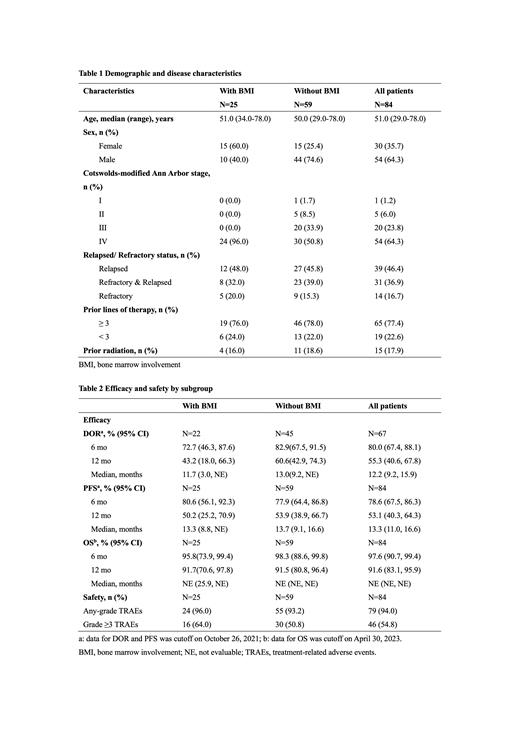Background
In our previous phase 2 trial (NCT04370405), linperlisib, an oral phosphatidylinositol 3-kinase delta (PI3Kδ) inhibitor, demonstrated encouraging activity and manageable safety in adult patients with relapsed/refractory (R/R) follicular lymphoma (FL) who had received at least 2 prior systemic therapies. It's crucial to note that FL patients with bone marrow involvement (BMI) generally present more unfavorable prognosis. Here, we present a subgroup analysis from this phase 2 study, which is specifically focused on BMI at baseline.
Methods
Details of the trial design and study population have been previously reported. In brief, eligible patients (age > 18 years; histologically confirmed relapsed or refractory FL; disease progression post at least 2 prior systemic therapies) received 80 mg linperlisib tablets daily in a 28-day cycle, until disease progression or unacceptable toxicity. The primary endpoint was objective response rate (ORR) assessed by independent review committee (IRC); secondary endpoints included the duration of response (DOR), disease control rate (DCR), progression free survival (PFS), overall survival (OS) and safety profile. For this subgroup analysis, patients were grouped based on the presence or absence of BMI at baseline. For those with baseline BMI, biopsies were evaluated to confirm complete responses. Evaluations of antitumor response were conducted every 2 treatment cycles, following the guidelines of the International Research Working Group.
Results
As previously reported, 84 patients included in the full analysis set (FAS). By subgroup, 25 had baseline BMI and 59 did not. Baseline characteristics by subgroup are shown in Table 1.
In this subgroup analysis, a trend toward higher response rate was seen in R/R FL patients with BMI compared to those without such involvement: ORR based on IRC assessment was 88.0% vs 76.3%; best overall response (BOR) of CR was 24.0% vs 11.9%; BOR of PR was 64.0% vs 64.4%. Patients with BMI had DCR that was consistent with those without BMI (92.0% vs 93.2%). The median DOR and PFS were similar across this subgroup (DOR: 11.7 months vs 13.0 months; PFS: 13.3 months vs 13.7 months) (Table 2). Although the median OS was not reached, 12-month OS rates for patients with and without BMI was 91.7% and 91.5%, respectively (Table 2).
Safety was evaluated in all R/R FL patients who had received ≥1 dose of linperlisib. Rates of any-grade treatment-related adverse events (TRAEs) were similar across this subgroup and comparable with the overall population (Table 2). When compared to the overall population, patients without BMI experienced fewer grade ≥3 TRAEs, while a marginally higher incidence of grade ≥3 TRAEs was observed in patients with BMI (Table 2).
Conclusions
This subgroup analysis indicated that linperlisib is an effective and well-tolerated treatment option for patients with R/R FL, irrespective of BMI. Although minor differences were observed in this subgroup, their significance is limited due to the small sample sizes and probably do not alter the overall clinical benefit of linperlisib. Nevertheless, these findings warrant further investigation.
Disclosures
Fu:Takeda Pharmaceutical Company Limited.: Research Funding; Shanghai Changzheng Hospital: Other: WJF is a former staff of Shanghai Changzheng Hospital and now is a staff of Shanghai Fourth People's Hospital affiliated to Tongji University. .


